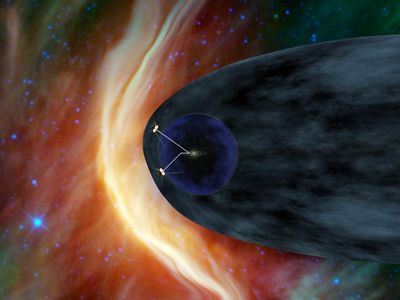
In which direction is the sun's stream of charged particles banking when it nears the edge of the solar system? The answer, scientists know, is blowing in the wind. It's just a matter of getting NASA's Voyager 1 spacecraft in the right orientation to detect it.
To enable Voyager 1's Low Energy Charged Particle instrument to gather these data, the spacecraft performed a maneuver on March 7 that it hadn't done for 21 years, except in a preparatory test last month.
At 9:10 a.m. PST (12:10 p.m. EST), humanity's most distant spacecraft rolled 70 degrees counterclockwise as seen from Earth from its normal orientation and held the position by spinning gyroscopes for two hours, 33 minutes. The last time either of the two Voyager spacecraft rolled and stopped in a gyro-controlled orientation was Feb. 14, 1990, when Voyager 1 snapped a family portrait of the planets strewn like tiny gems around our sun (http://photojournal.jpl.nasa.gov/catalog/PIA00451).
"Even though Voyager 1 has been traveling through the solar system for 33 years, it is still a limber enough gymnast to do acrobatics we haven't asked it to do in 21 years," said Suzanne Dodd, Voyager project manager, based at NASA's Jet Propulsion Laboratory in Pasadena, Calif. "It executed the maneuver without a hitch, and we look forward to doing it a few more times to allow the scientists to gather the data they need."
The two Voyager spacecraft are traveling through a turbulent area known as the heliosheath. The heliosheath is the outer shell of a bubble around our solar system created by the solar wind, a stream of ions blowing radially outward from the sun at a million miles per hour. The wind must turn as it approaches the outer edge of the bubble where it makes contact with the interstellar wind, which originates in the region between stars and blows by our solar bubble.
See the website for more details.
http://www.nasa.gov/mission_pages/voyager/voyager20110308.html (SY)
